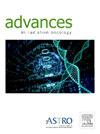部分代谢反应的原发性纵隔 B 细胞淋巴瘤患者的预后:多中心回顾性分析
IF 2.7
Q3 ONCOLOGY
引用次数: 0
摘要
许多原发性纵隔b细胞淋巴瘤(PMBCL)患者在初始全身治疗后仅获得部分代谢反应(PMR)。然而,关于其结果的数据有限。本研究旨在描述PMBCL患者实现PMR的结局,并确定指导这些患者适当治疗的因素。方法和材料我们回顾了2009年1月至2021年9月在2个独立癌症中心治疗的PMBCL患者。采用改进的Lugano标准(2014),评估化疗结束时正电子发射断层扫描(PET)结果以评估反应。使用Kaplan-Meier方法估计化疗结束PET扫描日期的无进展生存期(PFS)和总生存期(OS)率。结果151例年龄在15 ~ 65岁的PMBCL患者开始接受全身治疗,并进行了氟脱氧葡萄糖PET扫描以评估疗效。其中,55例(36%)达到不完全代谢缓解(IMR)(多维尔评分[DS] 4或5):13例(8%)在全身治疗中进展(DS评分为5),42例(27%)达到PMR (DS评分为4)。所有IMR患者(N = 55)的4年PFS和OS率分别为73%和72%。PMR治疗包括36例(86%)患者的巩固放射治疗(RT), 3例(7%)患者的进一步化疗,3例(7%)患者的观察。所有PMR患者的4年PFS和OS分别为83%和81%,接受rt治疗的患者的4年PFS和OS分别为89%和87%。SUVmax≤5的患者4年PFS(74%)低于SUVmax≤5的患者(95%),但差异无统计学意义(P = .07)。3例PMR患者均无复发。结论PMBCL患者常出现IMR。PMR (DS评分为4分)与随后的RT治疗与良好的预后相关。SUVmax可以识别需要更多或更少强化治疗的患者。本文章由计算机程序翻译,如有差异,请以英文原文为准。
Outcomes of Primary Mediastinal B-cell Lymphoma Patients with Partial Metabolic Response: A Multicenter Retrospective Analysis
Purpose
Many patients with primary mediastinal B-cell lymphoma (PMBCL) achieve only a partial metabolic response (PMR) after initial systemic therapy. However, limited data exist on their outcomes. This study aimed to characterize outcomes in patients with PMBCL who achieve PMR and identify factors guiding appropriate treatment for these patients.
Methods and Materials
We reviewed patients PMBCL patients treated at 2 independent cancer centers from January 2009 through September 2021. Using the modified Lugano criteria (2014), end-of-chemotherapy positron emission tomography (PET) scan results were evaluated to assess response. Progression-free survival (PFS) and overall survival (OS) rates from the end-of-chemotherapy PET scan date were estimated using the Kaplan-Meier method.
Results
A total of 151 patients with PMBCL aged between 15 and 65 years were initiated on systemic therapy and underwent a fluorodeoxyglucose PET scan to evaluate response. Of these, 55 (36%) achieved incomplete metabolic response (IMR) (Deauville score [DS] 4 or 5): 13 (8%) progressed on systemic therapy (a DS score of 5), and 42 (27%) achieved a PMR (a DS score of 4). The 4-year PFS and OS rates for all patients (N = 55) with IMR were 73% and 72%, respectively. PMR management included consolidative radiation therapy (RT) in 36 patients (86%), further chemotherapy in 3 patients (7%), and observation in 3 patients (7%). Four-year PFS and OS among all patients with PMR were 83% and 81%, respectively, and 89% and 87% among those receiving RT. Patients with PMR with maximum standard unit value (SUVmax) > 5 had a lower 4-year PFS (74%) compared with those with SUVmax ≤ 5 (95%), although this difference did not achieve statistical significance (P = .07). None of the 3 patients with PMR under observation relapsed.
Conclusions
Patients with PMBCL often have an IMR. PMR (a DS score of 4) managed with subsequent RT is associated with excellent outcomes. SUVmax may identify patients who may require more or less intensive treatment.
求助全文
通过发布文献求助,成功后即可免费获取论文全文。
去求助
来源期刊

Advances in Radiation Oncology
Medicine-Radiology, Nuclear Medicine and Imaging
CiteScore
4.60
自引率
4.30%
发文量
208
审稿时长
98 days
期刊介绍:
The purpose of Advances is to provide information for clinicians who use radiation therapy by publishing: Clinical trial reports and reanalyses. Basic science original reports. Manuscripts examining health services research, comparative and cost effectiveness research, and systematic reviews. Case reports documenting unusual problems and solutions. High quality multi and single institutional series, as well as other novel retrospective hypothesis generating series. Timely critical reviews on important topics in radiation oncology, such as side effects. Articles reporting the natural history of disease and patterns of failure, particularly as they relate to treatment volume delineation. Articles on safety and quality in radiation therapy. Essays on clinical experience. Articles on practice transformation in radiation oncology, in particular: Aspects of health policy that may impact the future practice of radiation oncology. How information technology, such as data analytics and systems innovations, will change radiation oncology practice. Articles on imaging as they relate to radiation therapy treatment.
 求助内容:
求助内容: 应助结果提醒方式:
应助结果提醒方式:


